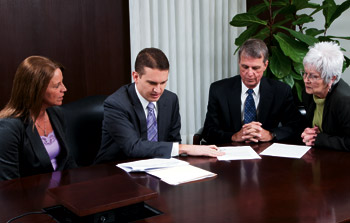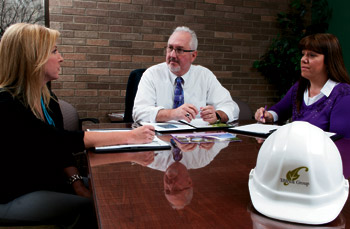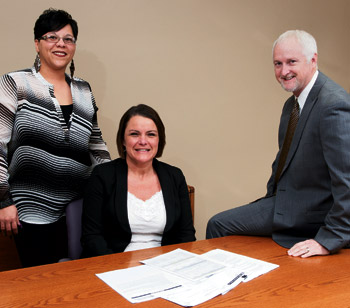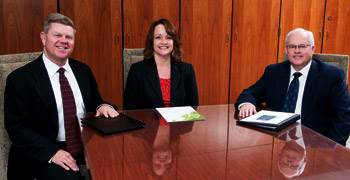Marketing Agency of the Month
The transformation
Fun and excitement return as Tedrick Group changes to consultative and diagnostic approach
By Dennis H. Pillsbury
Improving clients' overall risk profile is at the heart of Tedrick Group's risk analysis program. As part of that process, Sally Cesar (right), Executive Vice President of client Christopher Rural Health Planning Corporation, meets with agency representatives (from left) Cheryl Kwiatkowski, Account Manager, Compliance Specialist; Chad Brandon, MBA, Risk Architect, Compliance Specialist; and Roger Tedrick, President, Certified Risk Architect.
Tedrick offers educational symposiums to clients. Members of the team that organizes the sessions include from left: Carrie Wheeler, Agency Administrator, Compliance Specialist; Greg Richey, Certified Risk Architect; and Desi Grasher, Account Manager, Claims Manager.
The Benefits team includes, from left: Tatia Wesley, Risk Management Consultant, Compliance Specialist; Shelly Lampley, Account Manager; and Scott Giles, Risk Management Consultant.
Members of the Transportation/Trucking team include (from left): Mark Weimer, Certified Risk Architect; Lisa Champlin, Account Manager; and Brad Williams, Certified Risk Architect.
"The best tool you can have is a unique value proposition," Certified Risk Architect® Chad Brandon maintains in explaining why he joined The Tedrick Group, Mt. Vernon, Illinois, in April of 2010. "That got me really excited about The Tedrick Group. It's been fun going out and helping clients identify and mitigate their risks."
Founder and Certified Risk Architect Roger Tedrick adds, "We were able to recruit Chad because of the new process we had put into place following my attendance at an Organic Growth Engine™ (OGE) meeting in 2009." (Chad had been working in Chicago in commercial banking following graduation from Southern Illinois University. He also received an MBA from DePaul University, which he earned while working full-time in banking. He wanted to return to southern Illinois to raise his family, and the position at The Tedrick Group allowed him to do so.)
Roger continues: "We were looking for a different way of doing business following difficult losses to our revenue when the soft market and economic meltdown occurred. We lost 30% of our revenue without losing a customer."
Great service isn't enough
That's right, they didn't lose a customer. So clearly, they were doing something right. But being prey to the "boom and bust" vicissitudes of the commercial insurance cycle was not something to which they wanted to become accustomed.
"My wife and I started the agency in 1984," Roger says. "We had good growth each year as we focused on large commercial accounts in three key areas—construction, transportation and oil and gas. We're in a rural area with only about 17,000 people in town, so we spread out through most of southern Illinois to reach about 500,000. By focusing on larger accounts, our goal was to develop a healthy revenue per employee so we could keep and attract good people who could provide the excellent service on which we built our reputation."
So, after nearly 25 years of consistent strong growth, what went wrong? That was the question of the hour.
The problem was that the agency was servicing a commodity—insurance—and when the price of that commodity dropped, so did the revenue. And, when the downturn hit at the same time as a soft market, customers began to look for help from the agency in the form of lower prices, further impacting revenue. And that was exacerbated by the fact that one of the agency's important niches—construction—was hit hard by the housing crisis that precipitated the downturn. They were indeed trusted advisors who helped their customers lower the cost of transferring risk and stood shoulder-to-shoulder with them whenever there was a claim, but that only placed the agency on the expense side of the customer's balance sheet. And when times got tough, that was not a comfortable place to be.
The solutions
The first step the agency took was to broaden its base by adding another focus niche that likely was immune, or at least less susceptible, to economic swings. "We were looking for a recession-proof area," Roger notes. "We only had to look around to see that one area was still growing, even during the downturn, and that was health care. We decided to expand our efforts to physician groups and hospitals."
The second step was more difficult. It involved transforming the agency so that "our consultants would be able to offer a unique value proposition to prospects that would set us apart from the competition and make us risk management partners with every client we had," Roger says. "That's what my experience at the OGE meeting had convinced me that we needed. I got back to the agency and was ready to go.
"But I was a little naïve about what it would take. Literally, it meant that we had to change completely the way we did business. We had to go back to school to learn risk mitigation. Fortunately, I have a great team of people who have supported the agency's efforts and stayed with us through good times and bad. The average tenure of our support staff is 14 years and our consultants' tenure is just a little higher at 15 years. I can honestly say that they truly represent some of the best and the brightest in our industry. They had a lot of knowledge about the business and an enthusiasm to learn more. And that's exactly what I was asking them to do—learn a lot more."
Becoming the client's partner
The new process involves developing an in-depth knowledge of each client's business. "We use a team approach when we go out to a client or prospect," Chad says. "Property and casualty consultants and benefits consultants work together in order to provide a more holistic approach.
"During the first interview, we find out about their business and where they are successful and where they struggle. I don't bring up insurance at all. I don't mention X-dates. That's just not part of the process. We aren't there to quote business; we're there to help them solve problems that they face. No risk is off the table. If it's something that can impact the client, then it's something we need to find a way to mitigate."
"We follow up with employee interviews," Roger continues. "We try to interview a broad sampling of employees for every organization. Naturally, that takes a team effort—usually five or six people from our office get involved.
"We're always surprised at what we learn and sometimes the management of the client or prospect is as well. The hourly workers often have a different view of what the risks are and how they can be mitigated. Sometimes, management is unaware of some of the risks and is often surprised that the workers not only know about them, but often are trying to mitigate them in whatever way they can. We can come in and work with both management and hourly workers to devise the best mitigation program for all the risks."
Chad picks up from there. "As our benefits consultants and property and casualty consultants work together, we explain how a risk management strategy for benefits has a direct correlation with a safety program. For example, healthier workers are less likely to get injured on the job and, if they do, they recover more quickly. And it provides tangible evidence that management cares, resulting in an almost instantaneous improvement in morale, with a concomitant drop in absenteeism and presenteeism. And that means that workers are more productive, resulting in a better bottom line for our clients."
"So now we're not only helping our clients cut costs by improving their risk profile, we're also helping drive improvements in productivity, putting us on both sides of the ledger," Roger says.
Getting there wasn't easy
"Overall, it took two and a half years to effect the transformation," Roger says. "Our consultants had to learn a new way to approach clients and to work together as a team when approaching certain accounts, in addition to learning more about risk mitigation. Fortunately, they already had a deep knowledge of the insurance business and risk management. Each consultant also went through the exclusive Certified Risk Architect program so they could gain an even deeper understanding of the process we were trying to implement."
And was it worth it?
"Last year, we had 20% growth to reach $2.6 million in revenue," Roger says proudly. "But even more important is how well the process is working to transform the agency internally, as well as changing our relationship with clients. It's just wonderful to see how every one of our 14 employees is part of a team and is having fun. They can see every day how they are helping clients grow and prosper, and that's very gratifying."
Chad admits that this is the only process he has worked with in the insurance business, but "I can't imagine working any other way. We all get along and every day we are learning and changing as our clients grow and change. We get involved in conversations that never would have occurred under the previous way of doing business. And the result is that we find new areas where we can help our clients.
"I can think of several examples," he continues. "One of the biggest issues organizations face today is managing human capital. So now we have an HR consultant that we've contracted with to provide solutions to human capital risk issues. Business continuation planning is a real concern for many of the businesses with which we deal. That's now something we include in our initial interviews and have the resources to help them if that is a concern. We also provide OSHA training resources and educational symposiums for our clients.
"The most cutting edge tool we use is something to benchmark, or measure, an organization's risk management program. We can quantify where a company is currently with a particular safety program, and then put an action plan together with specific steps to improve or enhance the safety program."
Roger admits that the process involves more work than simply going out and quoting business. The risk assessment process is ongoing for clients and certainly intensive for prospects. "But what we're doing is qualifying prospects. So even though we spend more time per prospect, our hit ratio justifies that added expenditure." And then, he adds, after a dramatic pause, "Our hit ratio is better than 90%."
A little help from their friends
"One of the things that has grown out of this process is our prospect research advisory board," Chad says. "The board consists of leaders from our centers of influence who help us formalize prospect research on both a selective and strategic basis. This is just starting for us, but we're excited about the successes we've already experienced and what it means for our future growth. We're definitely getting better at this."
"Our goal for the next five years is to double our revenue," Roger says, adding quickly that "it's not about the money. It's about having the resources to bring more risk management support to our clients. At the end of the day, it's the right thing to do."
And doing the right thing is what The Tedrick Group is all about and the main reason that we at Rough Notes are proud to recognize them as our Marketing Agency of the Month.





